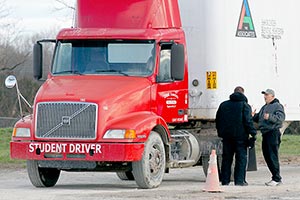Trucking Schools Struggle to Find Teachers as Driver Demand Soars

The commercial trucking industry has struggled with a shortage of drivers for at least a decade, but now Clark County, Ohio, educators and driving schools throughout the state face a hard time finding instructors as well.
The driver shortage creates a ripple effect on the economy, according to a 2015 report from American Trucking Associations. That report showed close to 70% of all freight tonnage in the United States is shipped across the country’s highways and the industry was short about 38,000 drivers in 2014.
That shortage is expected to balloon to as much as 175,000 drivers by 2024 if the current trend holds.
And now a lack of instructors will make it even tougher to fill the rising demand for new drivers, said Tom Hicswa, director of the Commercial Transportation Training Center at Clark State Community College.
“We’ve tried every kind of advertisement we can think of,” Hicswa said.
Part of the challenge at Clark State is that while the jobs pay about $20 an hour, they’re often part-time and don’t come with benefits, he said.
The Ohio Trucking Association doesn’t keep statistics on instructor shortages, said Thomas Balzer, president of the OTA. But he said the driver shortage has been a problem for at least a decade.
“That was the No. 1 issue 10 years ago, and it has progressively gotten worse, and it will continually get worse as we go forward,” Balzer said.
Like Clark State, other driving schools across Ohio also reported facing a similar lack of instructors within the past year.
“We have schools across the country, and I think all of our schools are struggling to find instructors,” said Jeff Whittington, site director for Roadmaster Driver’s School of Ohio in Columbus. “Obviously we can’t pay what a driver would make going over the road so it’s hard to compete with that.”
Many of the instructors at Roadmaster can receive a full schedule and benefits, Whittington said.
“Finding instructors is kind of a new problem for us,” Whittington said. “It used to be we didn’t even run ads and we’d have people call us. But it’s kind of changed and we have to do a lot of advertising to get candidates and of course they have to be qualified.”
And just because a driver has years of experience doesn’t necessarily translate into teaching ability, said Mike Moscinski, vice president at Trainco Truck Driving School in Perrysburg, Ohio.
One of the benefits of a teaching job is it allows workers to be home every night, but it also typically pays less, Moscinski said. But since the Great Recession, he said many drivers who might have considered teaching have opted to continue to drive for as long as possible because they can earn more.
“First and foremost, there’s a shortage of truck drivers across the country so a lot of it is because baby boomers are retiring,” Moscinski said. “It’s a heavily regulated industry, and a lot of people don’t get into it for those reasons.”
For now, Whittington said his school will likely take a wait-and-see approach to see if the issue improves.
“Our company is certainly aware of it at the corporate level, and they’re looking at things they can change to attract people but we haven’t really come up with any solutions yet,” Whittington said. “It is on their radar and they’re trying to work on it.”
At Clark State, Hicswa said he could use at least two more instructors and noted the class sizes are often limited when teaching parts of the program. Without qualified instructors, it’s tougher to provide enough classes to meet growing demand for new drivers, he said.
“It’s like a never-ending circle,” Hicswa said.

